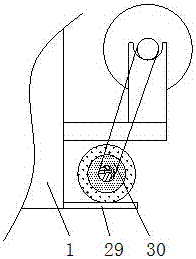Textile fluff removal device
A textile and brush roller technology, which is applied in textiles, papermaking, and fabric surface trimming, can solve problems affecting the quality of textiles, achieve the effect of flexibly scraping off impurities on the surface of fabrics, improve production quality, and ensure hygiene
- Summary
- Abstract
- Description
- Claims
- Application Information
AI Technical Summary
Problems solved by technology
Method used
Image
Examples
Embodiment Construction
[0021] The following will clearly and completely describe the technical solutions in the embodiments of the present invention with reference to the accompanying drawings in the embodiments of the present invention. Obviously, the described embodiments are only some, not all, embodiments of the present invention. Based on the embodiments of the present invention, all other embodiments obtained by persons of ordinary skill in the art without making creative efforts belong to the protection scope of the present invention.
[0022] see Figure 1-6 , a textile hair removal device, comprising a housing 1, the two ends of the inner cavity of the housing 1 are movably installed with guide rollers 12, the number of guide rollers 12 is four, and between the four guide rollers 12 is Symmetrically arranged, the upper left end of the inner cavity of the housing 1 is fixedly equipped with a first support seat 19, the bottom of the first support seat 19 is fixedly connected with a first slee...
PUM
 Login to View More
Login to View More Abstract
Description
Claims
Application Information
 Login to View More
Login to View More - R&D
- Intellectual Property
- Life Sciences
- Materials
- Tech Scout
- Unparalleled Data Quality
- Higher Quality Content
- 60% Fewer Hallucinations
Browse by: Latest US Patents, China's latest patents, Technical Efficacy Thesaurus, Application Domain, Technology Topic, Popular Technical Reports.
© 2025 PatSnap. All rights reserved.Legal|Privacy policy|Modern Slavery Act Transparency Statement|Sitemap|About US| Contact US: help@patsnap.com



